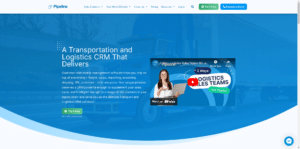The majority of salespeople, 75 percent, suck at selling.
According to Dennis Connelly, vice president of business development at Kurlan, “For lack of a better word, they suck.” This isn’t just speculation either; there’s a mountain of data to back this up.
What kind of data?
The Objective Management Group has evaluated more than 2,204,760+ salespeople, in 34,370 companies, across 200 industries and 151 countries over the last 32 years. Here’s what their research found.
- 6% of salespeople are “elites,” they’re great at selling
- 20% of salespeople are doing well, but there’s room for improvement
- 74% are failing at sales
- The bottom 25% are failing, but they’re also unteachable
It’s all their fault, isn’t it?
These salespeople simply need to take responsibility for their success if they want to see any improvement. At least that’s the rationale many sales managers have, right?
What if they’re wrong?
What is sales enablement again?
In my previous post, I laid out the definition of sales enablement.
It’s an iterative process that provides your sales team with the support, process, tools, and training they need to meet and exceed your sales goals.
This definition is actually incomplete.
Sales enablement has two facets of competence. You’ll need to be able to manage both to build a successful sales team.
- What your organization invests in its sales team: This refers to the support, process, tools, and training your organization invests into your salespeople to help them achieve consistent results. A company’s willingness to invest in its team determines the results it can achieve.
- What your individual salespeople invest in themselves: This refers to the core competencies, skills, knowledge, and abilities a salesperson brings to the table. These employees are among the top 10% of talent in their industry or niche.
Most of the content on sales enablement is oriented around what the organization invests in its sales team. This makes sense when you think about it because these details are the easiest for managers to control. However, this view is incomplete because it neglects the sales team’s role in the enablement process.
This decreases the overall value of sales enablement.
What is the value of sales enablement?
Is sales enablement worth it for organizations today? It seems like there are questions about whether the value is there. The State of Sales Enablement Report shows us that the more committed an organization is to sales enablement, the more value generates. When companies consistently use sales enablement tools and practices, they have:
- 13% higher win rates compared to those without
- 25% less turnover compared to those without
- 11% higher quota realization
What about the value overall?
- 76% of companies that adopt sales enablement see a 6% to 20% in sales
- Companies see a 31% improvement in sales messaging
- A 15% improvement in low performing salespeople
- A 20% improvement in (new) sales productivity
- A 25% improvement in skill deficiencies
These numbers are especially significant when you realize that the average turnover was 26% (in 2020), with almost half of the companies surveyed reporting turnover rates of more than 30%.
The value is there.
The real question is how you go about unlocking that value in your organization.
How to 2x revenue per customer with sales enablement
Your managers want sales and revenue; your sales team wants large commission checks. You’ll need to take a layered approach if you’re going to 2x your revenue per customer.
What exactly does this mean?
- Hire the right salespeople
- Implement sales enablement
- Identify your customer’s desires, goals, fears, problems, and frustrations
- Iterate to improve performance, conversion rates, upsells and cross-sells
Let’s take a closer look.
1. Hire the right salespeople
Successful sales enablement begins with the right team.
If you’d like to 2x your revenue per customer, you’re going to need a highly competent sales team. You’ll need proven methodologies you can use to find, attract, and measure your sales team’s performance.
Does that methodology exist?
It does.
Topgrading, an empirically proven hiring methodology created by Dr. Bradford Smart, helps companies like yours attract A-player salespeople. A-player sounds generic, doesn’t it? When we break this down, we see that it’s actually a precise term.
What is an A player?
Smart defines an A player as the top 10 percent of talent available for any job at a given salary.
Here’s why that matters.
Jim Collins, author of the book, Good to Great, explains why your company needs top-tier talent: “Those who build great companies understand that the ultimate throttle on growth for any great company is not markets, or technology, or competition, or products. It is the one thing above all others; the ability to get and keep enough of the right people.”
Remember the data points I mentioned earlier?
- 6% of salespeople are “elites,” they’re great at selling
- 20% of salespeople are doing well, but there’s room for improvement
- 74% are failing at sales
- The bottom 25% are failing, but they’re also unteachable
Here’s why this matters.
Your salespeople attract candidates who are just like them. If your sales team consists of mostly B and C player employees, you’ll attract more of the same — more B and C-player candidates. If you have A-players “elites” on your sales team, you’ll draw more A-players to your organization.
A-players are must-haves.
A-players motivate poor performers to improve or leave. These elites boost productivity, increase profitability, and generate more revenue per customer. If you want your sales enablement programs to succeed, you need top-tier talent.
2. Implement sales enablement
I mentioned the components you’d need for profitable sales enablement in my previous post. Here’s a quick recap of each element.
- Sales training: Your sales training should include both internal and external data. Do your training should provide your sales team with the A to Z information they need to attract and close prospects.
- Sales tools: These are the tools and resources your sales team will need to keep up with the demands and expectations you’ve placed on them. These are automation, CRM, lead scoring, prospecting, and analytics tools.
- Sales process: What should A-player’s day look like? How many customers do they need to talk to each day? How many deals do top performers close per day? You provide your high-performance team with a detailed yet customizable process they can follow to achieve success.
- Product development: When your sales team collects customer feedback, what happens to it? A-players know executives listen to customers — they’ll provide them with the video, audio, or review feedback needed to initiate change. Here’s the thing about A-players, they expect management to take action on the customer feedback they collect.
These components aren’t optional.
If you’d like to attract and retain your A-player team, you’re going to need a strong sales enablement program. Your sales enablement framework will need to provide your team with each of the above components.
3. Identify your customer's desires, goals, fears, problems, and frustrations
Have your salespeople survey your customers consistently. You’ll want to confirm the obvious answers and discover the hidden details customers aren’t sharing. Here’s what you’ll want your sales team to identify.
- Company and product-specific data on your customer’s desires, goals, fears, problems, and frustrations. Are they irritated with your delivery times? Did your company’s product fail to perform, or did it exceed their expectations? What’s the most frustrating part about doing business with your organization?
- What deep desires motivate them to purchase your products or services? Do these desires conflict with their goals?
- Were customers afraid to make a purchase or do business with your company at first? What made them feel comfortable or motivated them to buy? What are the risks of doing business with you? Does your organization have a solution in place to address these fears/risks?
- What problems do they expect your products or services to solve? Are those problems discussed in the company’s marketing, or is there a conflict? What problems do your products create? (every product creates a new set of problems that needs to be solved — for example, buying a car beings customers now have to pay for insurance, taxes, gas, maintenance, etc.).
- What sort of goals are at play here? Are they obvious goals (e.g., make more money, save money or time) or hidden goals (e.g., use your quote as leverage to get a better deal, spend the remaining budget so we don’t lose it)?
Don’t badger prospects; just ask these questions naturally, then add them to your CRM tool of choice.
Trends are what’s important here.
Let’s say you have 800 customers and 15 salespeople. If they ask two questions each month, that’s 12,000 answers. If you have a list of questions and you go through them carefully, you should be able to accumulate a treasure trove of data.
Here’s why that matters.
You can compare that with the data your marketing team receives. You can use this data to:
- Make changes to sales and marketing messages
- Spot check your marketing
- Create new split tests for specific products and offers
The sky’s the limit here.
Your marketing team has a list of your best-performing content and campaigns. They also have detailed information on your customers, including demographics, psychographics, ethnographics, etc.
You do too.
Combine your data with marketing, and suddenly you know which offers are more likely to work. This means you can request specific pieces of content from marketing that you know will perform well. You’ll know what customers want, how to give it to them, how to overcome their objections, create the perfect offers, and more.
Once you’ve done this, you’re ready for the next step.
4. Iterate to improve performance, conversion rates, upsells and cross-sells
At this point, you’re ready to reach out to your product managers.
Remember them?
If you provide product teams with the sales and marketing data you’ve accumulated from customers they can make improvements. One perspective matters above all – your customers. Using this data, you can create products and services that are objectively and demonstrably better or worse than your competitor’s.
This is crucial.
Your product and service teams can create micro-test products customized around the data you’ve just received. You can sell it to the customer segments or cohorts that fit perfectly with your research.
Why start with a micro campaign?
Because executives don’t listen to product managers either!
A micro campaign enables you to accumulate some quick wins and customer data you can use. Armed with the performance data you’ve received from sales, marketing, and product teams, you can negotiate for a bigger budget and a large, phased rollout.
This is how you 2x your revenue per customer.
This is how successful sales enablement is done. When A-players and sales enablement are a core part of your sales process, you’ll find it’s easier for your salespeople to attract, sell, and close new deals. The more support your sales team receives via sales enablement, the easier it is for your A-players to generate more revenue.
Most salespeople suck at selling. Sales enablement changes that
A team of A-players and a strong sales enablement program gives you the tools, training, and resources you need to meet your organization’s expectations.
The data backs this up.
An analysis of more than 2,204,760+ salespeople in 34,370 companies across 200 industries and 151 countries over the last 32 years confirms our suspicions.
A-player “elites” are the best at selling.
There’s room for improvement everywhere else.
As we’ve seen, Sales enablement has two facets of competence (1.) what your organization invests in your salespeople and (2.) what individual salespeople invest in themselves. You’ll need to be able to manage both to build a high-performance sales team.
Sales enablement begins with a who.
With the right team and a strong program, you’ll have the framework you need to 2x your revenue per customer, no sucking necessary.




